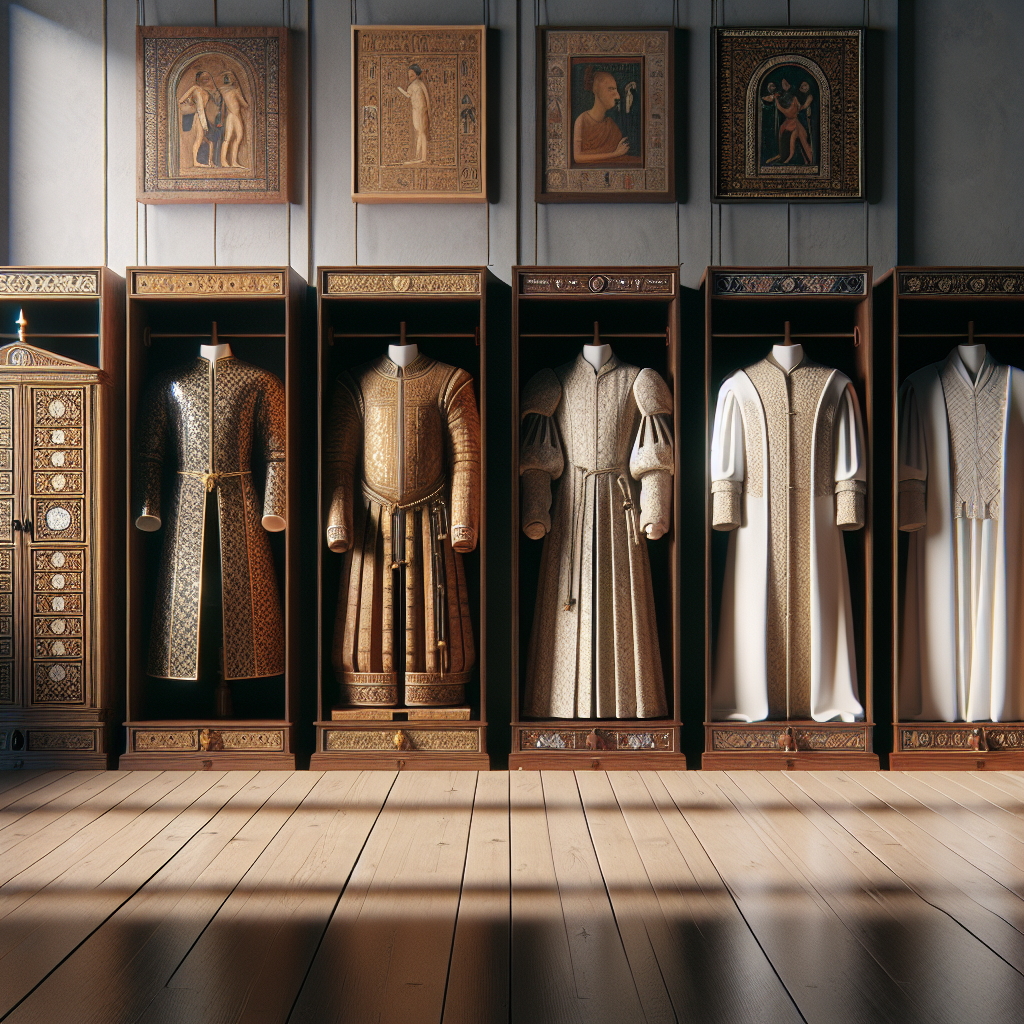The History of Wardrobes: A Fascinating Journey
The History of Wardrobes: A Fascinating Journey


A wardrobe might seem like a simple piece of furniture, but it carries with it an intricate history woven through centuries. Serving as storage for clothes and belongings since ancient times, wardrobes have experienced a diverse evolution over the years, acquiring various design transformations and functionalities, reflecting the needs and desires of different epochs. This journey, from basic storage solutions in Ancient Egypt to the modern smart wardrobes we see today in luxurious homes, highlights the fascinating progression of this vital furniture piece. Whether proudly displaying elaborately carved designs or concealing sliding shelves discretely inside, wardrobes are more than just mundane storage spaces; they are valuable snapshots of our historical and cultural past, shaped by the size and shape of the room they inhabit.
Origins of Wardrobes: Ancient Egyptian Storage Solutions
The initial form of wardrobes was in the realm of ancient Egypt, underlining their long-standing role in human civilisation. Historically, Egyptians held significant value toward personal grooming, and wardrobes were integral elements in the houses of wealthy individuals. Constructed from wood, these elementary prototypes of wardrobes served their purpose in retaining clothing, linen, and other precious items, exhibiting functionality and balance, principles that remain key in modern wardrobe construction. Thus, the roots of the wardrobe lie deeply embedded in ancient cultures, illustrating its primal need as a solution for storage.
Preservation and Decoration in Egyptian Wardrobes
While practicality was primary, aesthetics were not overlooked in ancient Egyptian wardrobes. Luxury versions of these wardrobes demonstrated intricate wood carvings, lush paintings, and insets with ivory, precious metals, and stones, including popular motifs such as religious scenes, musical instruments, cupid’s bow, flowers, and leaves. These decorative elements created elaborate art forms in addition to being functional furniture pieces. The tradesman would impressively decorate these pieces to flaunt the wealth and social status of the owner, reinforcing the idea of wardrobes as status symbols, a notion that significantly continues in today's world.
The Etymology of the Word "Wardrobe"
The term "wardrobe" originates from the Old French words 'warderobe' and 'warderobe’,' which mean a room for keeping clothing. It first appeared in the English language during the middle ages. In the 14th century, it referred to a room used for storing clothing. The word evolved, and by the 16th century, it also denoted a piece of furniture for hanging or folding clothes. Throughout history, the design and use of wardrobes have undergone significant transformations, reflecting changes in fashion, interior design, and the mass production of furniture.
Wardrobe Evolution: From Armoires to Kas Styles
As civilisation advanced and societal requirements evolved, so did the concept of wardrobes. Transformations took place from simple chests to standing closets, marking the birth of armour in regal palaces and noble castles before reaching common households. The Dutch kas emerged as another variant of wardrobes, epitomising a comprehensive cupboard to accommodate linens, clothing, and valuable possessions—signifying notable advances within the scope of furniture design in the 17th century.
The European Influence on Wardrobe Designs
European influence wrought significant transformations in wardrobe appearances and functionalities, especially during the 19th century. The advent of:
● Hanging cupboards transforming wardrobes by integrating freestanding storage units.
● Full-length mirrors, which found their place on the central doors, enhancing both aesthetic and practical aspects of wardrobe design.
● Drawer designs, introduced to aid in compartmentalisation, serving as an essential function in modern wardrobes.
● Handiworks of European furniture geniuses such as Chippendale, Sheraton, and Hepplewhite, who played significant roles in shaping the evolution and grandeur of wardrobe design.
Influential Historical Periods and Their Impact on Wardrobes
Historical eras from the Queen Anne period through the Edwardian era, each brought unique elements to the style and form of wardrobe making. Achieving distinctive looks from the ornate to simpler designs, the wardrobe's journey accommodated both changes in taste and advancements in furniture making. Thus, providing a fascinating view into not just the history of this versatile furniture piece, but also into societal trends over centuries and their impact on modern design.
Queen Anne Era (1701 – 1714)
During the Queen Anne Era, wardrobes started exuding a distinctive elegance marked by gentle curves, domed tops, and elaborate panelling. Lighter woods like walnut and cherry were now used extensively, with many pieces being sourced from the American colonies. Emphasising fine craftsmanship, these wardrobes underscored an element of luxury in households of the time, with leading designers such as Daniel Marot and Jean Barein contributing significantly to the evolution of design aesthetics.
Georgian Era (1714 – 1830)
Era Influence: Adopting multiple styles like Baroque, Rococo, Chinoiserie etc
Material: Transition from Oak to American Walnut
Top Designers: Andre Palladio, William Kent, Thomas Chippendale, George Hepplewhite
During the Georgian period, wardrobes went through a phase of stylistic diversity. Evidently rich in design innovations, these pieces highlighted the sophistication and complexity of the craftsman's skills in that era.
Regency Era (1811 – 1820)
Compared to previous periods, the Regency Era (1811 – 1820) marked a departure with rhizomatic inspirations from different cultures such as Japan, Turkey, India, and Persia, bringing exotic influences to wardrobe design. Lively and exotic, the wardrobes now showcased dynamic artistry with impressive panelling, imbuing the pieces with ornate embellishments and unique textures. Distinguished designers playing pivotal roles in shaping these trends were luminaries like John Nash, Thomas Hope, William Moore, and Morel & Hughes.
Victorian Era (1837 – 1901)
The most significant era in metamorphosing wardrobes would arguably be the Victorian Era. Several transformations took place:
● Early wardrobe designs were magnificently extravagant to complement the plush fashion of the era.
● The introduction of full-length mirrors on central doors marked a significant design overhaul.
● Large wardrobes became status symbols more than ever, necessitating highly ornate carvings to contribute to the robust appearance.
● Advances in machinery during the 1860s changed the way wardrobes were constructed, also reducing manual involvement in carving and designing.
Edwardian Era (1901 – 1910)
Marking the end of an overly ornate Victorian Era, the Edwardian Era (1901 – 1910) brought a breath of fresh air with its lighter, fresher, and comparatively less extravagant designs. Drawing inspirations from the Art Nouveau movement, the wardrobes of this era, known as Edwardian wardrobes, step aside from the heavy opulence, opting for simpler aesthetics. The materials used took on warmer hues and the overall structure embodied a more delicate and approachable charm.
The Art Deco Wardrobe and Modern Innovations
The arrival of the Art Deco period introduced a bold revolution in wardrobe design that still carries influence in the current century. Not only did this period signify a firm departure from historical imitation, but it also merged elegant geometry with refined materials like polished mahogany, brass, and even glass in some cases. Simultaneously, wardrobes moved beyond being mere status symbols, aligning functional advantages with stylish visuals to satisfy modern needs and desires.
Glamorous Designs and New Materials
The Art Deco period led to the exploration of new materials beyond traditional woods. Use of glass, metal and even luxurious materials like ivory became widespread, marking a trend towards optimising both functionality and luxury. The inclusion of elements like full-length mirrors became standard, making wardrobes a critical element in dressing up. The sleek lines coupled with chic details in the structure reflected the dawn of the modern era in wardrobe design.
The Influence of Technology on Wardrobe Functionality
As technological advancements permeated all facets of life, wardrobes were no exception. Automation in rails, motion-activated lighting, and rotating shelves have all contributed to the "smartness" of modern wardrobes. These technologically-equipped wardrobes cater to the contemporary demands of ease, convenience, and smart storage solutions, ensuring our clothing and accessories remain organised and accessible with just the click of a button.
The Emergence of Smart Wardrobes
Today's wardrobes signify not just style but also technological innovation:
● Automated retrieval systems provide quick access to clothes and accessories.
● Motion-activated lighting installed inside drawers illuminate dark corners of the wardrobe.
● Rotating shelves and fan mechanisms make inaccessible items easily reachable.
● Design enhancements incorporate touch-sensitive screens enabling digital organisation and selection of attire.
Emerging as an inventive solution to storage, smart wardrobes save time and enhance the convenience of dressing routines.
The Rise of the Luxury Walk-in Wardrobe
The culmination of wardrobe evolution is arguably embodied in the luxury walk-in wardrobe—once the sole province of the wealthiest households, now a feature found in more aspirational homes. Offering unparalleled storage space and the sensation of having a personalised boutique at home, these walk-in wardrobes, also known as dressing rooms, translate to celebrating personal style while enjoying the luxury of abundant space.
The journey of a wardrobe is a fascinating narrative of evolution, reflecting broader themes of societal development and changing aesthetics through the centuries. Beyond being a practical storage space, wardrobes have graduated to become an expression of personal style, status symbols, and eventually, an integral part of our digital lifestyle. Incorporating the best of design, materials and functionality, they're a testament to the progress in the field of interior design, a consummate blend of the past, present, and future. As we look forward, we can only anticipate what the future might hold for this essential piece of furniture—the smart wardrobes of today may soon give way to increasingly innovative solutions that seamlessly blend technology, design aesthetic and eco-conscious manufacturing.
